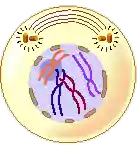Difference between Mitosis and Meiosis for Class 9, 10 and 11
Difference between Mitosis and Meiosis: Mitosis is a process where a single cell divides into two identical daughter cells (cell division). During mitosis one cell? divides once to form two identical cells.
The major purpose of mitosis is for growth and to replace worn out cells. In meiosis, two phases of chromosome segregation, meiosis I and meiosis II, follow a single round of DNA replication during the premeiotic S phase.
During meiosis I, homologous chromosomes segregate at opposite poles. The sister chromatids then segregate at opposite poles during meiosis II, resulting in the formation of non-identical haploid gametes.
Difference between Mitosis and Meiosis for Class 9, Class 10 and Class 11
| Mitosis | Meiosis |
|---|---|
| Mitosis discovered by Walther Flemming | Meiosis discovered by Oscar hertwig |
| Mitosis occurs in all organisms, except viruses | Meiosis occurs only in animals , plant and fungi |
| Mitosis create body / somatic cells | Meiosis crests germ / sex cells |
| Mitosis involves one cell division | Meiosis involves two successive cell division |
| Mitosis perform general growth repairs, Cell reproduction. | Meiosis perform genetic diversity through sexual reproduction |
Mitosis is the process where the division of cells occurs by asexual reproduction | Meiosis is the process Where the division of cells occurs by sexual reproduction |
| In mitosis number of chromosomes remain the same | In meiosis number of chromosomes reduce by half |
| In mitosis Tetrad formation does not occur. | In meiosis tetrad formation Occurs and it’s Consists of two sets of sister chromatids |
| In mitosis sister chromatids separate | In meiosis sister chromatids do not separate |
| In mitosis length of prophase is short. | In meiosis length of prophase I is long and it’s consist five stages are leptotene, zygotene, pachytene, Diplotene and diakinesis. |
What is mitosis
Somatic cells and stem cells divide by mitosis. Mitosis is completed through two main steps. Those two steps are karyokinesis (nuclear division) and cytokinesis (cytoplasmic division). Karyokinesis is completed through four steps
A. Prophase :
- In prophase, condensation of basically thin thread-like chromosomes starts.
- Due to this, they become short and thick and they start to appear along with their pairs of sister chromatids.
- Centrioles duplicate and each centriole moves to opposite poles of the cells.
- Nuclear membrane and nucleolus start to disappear.

B. Metaphase :
- Nuclear membrane completely disappears in metaphase.
- Chromosomes complete their condensation and become clearly visible along with their sister chromatids.
- All chromosomes are arranged parallel to equatorial plane (central plane) of the cell. Special type of flexible protein fibers (spindle fibers) are formed between centromere of each chromosome and both centrioles.

C. Anaphase :
- In anaphase, centromeres split and thereby sister chromatids of each chromosome separate and they are pulled apart in opposite directions with the help of spindle fibers.
- Separated sister chromatids are called as daughter chromosomes.
- Chromosomes being pulled appear like bunch of bananas.
- In this way, each set of chromosomes reach at two opposite poles of the cell.
D. Telophase :
- The chromosomes which have reached at opposite poles of the cell now start to decondense due to which they again become thread-like thin and invisible.
- Nuclear membrane is formed around each set of chromosomes reached at poles. Thus, two daughter nuclei are formed in a cell.
- Nucleolus also appears in each daughter nucleus. Spindle fibers completely disappear.
Cytokinesis: The cytoplasm divides by cytokinesis and two new cells are formed which are called as daughter cells. In this process, a notch is formed at the equatorial plane of the cell which deepens gradually and thereby two new cells are formed. However, in case of plant cells, instead of the notch, a cell plate is formed exactly along midline of the cell and thus cytokinesis is completed.
What is meiosis
Meiosis is completed through two stages. Those two stages are meiosis-I and meiosis-II.
Meiosis I: In meiosis-I, recombination / crossing over occur between homologous chromosomes and thereafter those homologous chromosomes (Not sister chromatids) are divided into two groups and thus two haploid cells are formed.
Meiosis II : Meiosis-II is just like mitosis. In this stage, the two haploid daughter cells formed in meiosis-I undergo division by separation of recombined sister chromatids and four haploid daughter cells are formed. Process of gamete production and spore formation occurs by meiosis. In this type of cell division, four haploid (n) daughter cells are formed from one diploid (2n) cell. During this cell division, crossing over occurs between the homologous chromosomes and thereby genetic recombination occurs. Due to this, all the four daughter cells are genetically different from parent cell and from each other too.
